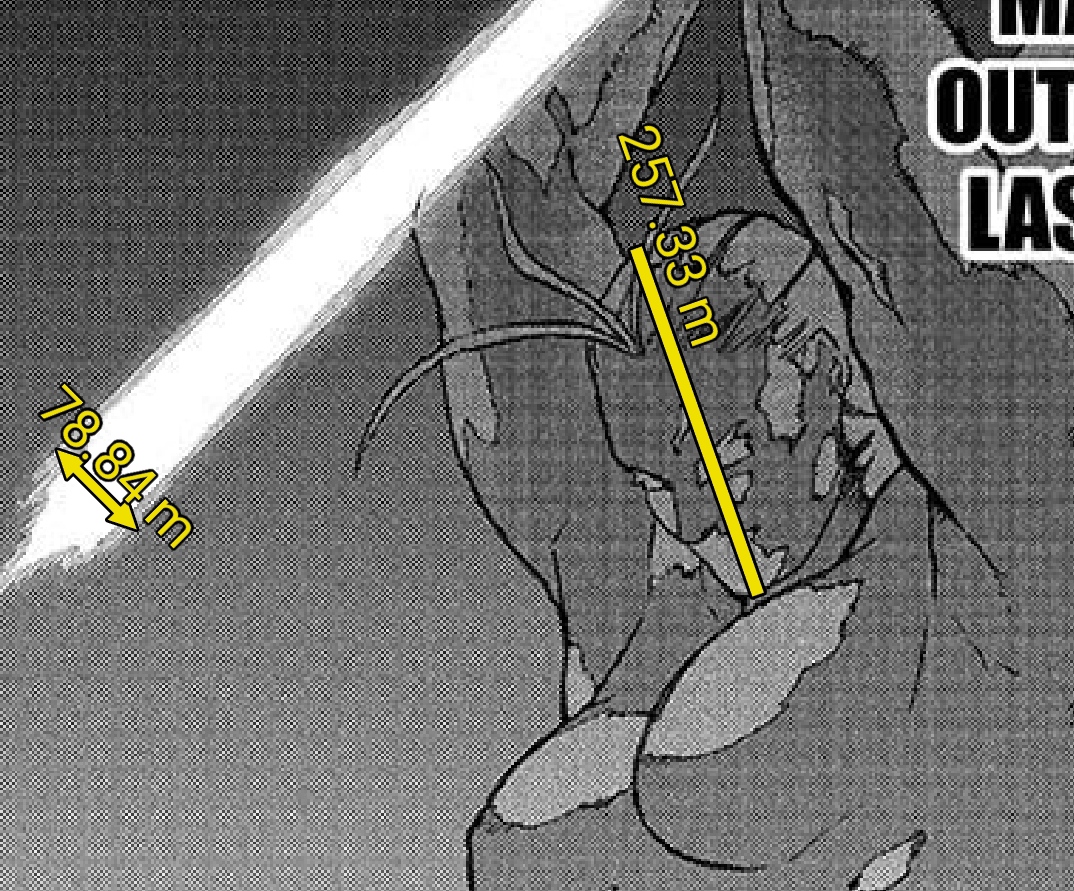- 31,693
- 28,280
- Thread starter
- #121
I think the High 6-C end has the most support
Okay, since the calculations appear to be acceptable but you're currently convinced that the High 6-C end has the most support, I will try my best to tackle why I think the High 6-C version of the calc is flawed.
From what I can tell the basis of the High 6-C calc is this:
1) Star and Stripe's avatar's canonical size values is what is used to find the width of the combined laser beam which in turn is used to find the dimensions of the Cloud Thickness and the Distance To The Ocean in the panel from Chapter 332.
2) The value for the Distance To The Ocean is then applied to the panel from Chapter 331 where the dispersion occurs in order to find the Dispersion Radius.
3) With all of those values, the volume of the dispersion and velocity of the dispersion can be found allowing the K.E. of the clouds of the calced.
There are issues with this method however. The main one being the contradicting visuals between the two panels while assuming for the sake of the calc that the visuals are also consistent.
There are three things we can actually get from scaling the panel in Chapter 332 here; the Dispersion Radius, the Cloud Thickness and the Distance To The Ocean. All three of those things can be scaled here from the combined laser.
Instead however, the Distance To The Ocean is then being applied to another panel... and that just doesn't work. See this little bit of pixelscaling here for reference. If the 1483.66 m value is used for the Distance To The Ocean, then the Cloud Thickness in that panel is at least 5713.39245614 m. So if the Cloud Thickness is impacted by using cross-panel scaling here and made inaccurate... then couldn't the same be happening for the Dispersion Radius?
This is because inherently the visuals aren't consistent. If the Distance To The Ocean is assumed to be a consistent value between the two panels, then the Cloud Thickness values will contradict each other. If the Cloud Thickness is assumed to be a consistent value between the two panels, then the Distance To The Ocean values will contradict each other. While we accept that no piece of art in any series is ever going to be perfectly consistent with each other as authors are only human, there is a contradiction too big to ignore here when just one of the multiple possible variables from the Chapter 332 panel is being selectively used here for a different panel's pixelscaling.
The second point I'd like to bring up is to reiterate the consistency in the positioning of the characters and why it would go against the assumptions required for the High 6-C calc.
Before the clap takes place, we know that Shigaraki is positioned a few hundred meters above the cloud layer based on the canonical size and positioning of Star and Stripe's avatar. Star and Stripe's avatar is positioned with the cloud layer around her hips.
When Shigaraki is punched back, the speed lines of the panel indicate horizontal movement as there are lines above and below them and they're extending towards the distance behind them, not below them. Now, we see that Star Stripe is following through with the clap immediately after the punch. There is no indication of vertical movement on her part; it is clear that Shigaraki and the Nomu can't have been travelling all that far as they're both still within range of her follow-up attack.
After the clap takes place, Shigaraki is shown to be at the level of the cloud layer. Bear in mind this must take place a matter of seconds after the clap took place as the only actions Star and Stripe has taken is to be shot with lasers which she combined into a single weapon and raised overhead to strike Shigaraki with, and this happened before Shigaraki and the Nomu were able to recover. We know their recovery speed is extraordinarily quick, as the High-End Nomu could shoot out the water as soon as Star and Stripe's laser holding it down went away.
If Tomura Shigaraki and the Nomu were launched into the air a distance of 20 km as the High 6-C calc's measurements would suggest, there simply wouldn't be any time for them to fall back that same distance. The assumption that the two of them were launched downward by the clap is inherently a baseless assumption as neither of the two show speedlines or other signs of significant velocity here. How does it make sense to justify an unlikely vertical ascension that is so high by coming up with an equally unsupported assumption that they were shot back down just as quickly?
So, we have indication that Tomura Shigaraki's and the Nomu's position remained consistent during the scene (not too far away from the cloud layer), and we have indication that Star and Stripe's position remained consistent too as the avatar is shown to be in the same place before and after the clap.
If you have to require the headcanon that Star and Stripe's avatar travelled vertically 20 km up in order to reach Shigaraki for the clap to take place, and then had to travel 20 km straight back down in order to get back to its original position for the scene to make any sense despite there being no signs of movement, then the nature of the calc itself does not seem heavily supported to me.
The third point I'd like to make is just to circle back to the topic of what it means for the calc to be supported. As established up above, the method for the High 6-C takes the value from one panel's pixelscaling and applies to to a different panel to get an extremely high Dispersion Radius value of 54 km. It is worth stressing how large this value is because of all the possible values we can get for it, this value is the least supported.
If we took the Dispersion Radius directly from the Chapter 332 panel (which gets us 1.6 km), even if that figure is hard to believe, it is still supported by the visuals in these two panels from Chapter 331 here and here. You've mentioned it is possible for things to be consistently wrong and I don't deny that. It is possible... But I'm not claiming to know with absolute certainty what the "true" value is here. We're making approximations as best we can using the limited evidence and methods available to us.
And I can say at least that value taken from Chapter 332 is more supported than the 54 km radius is. Weighing up the balance of evidence doesn't tell me which one is exactly right, but it does tell me which one requires more assumptions or is less consistent. And what I've posted up above currently has me believing that the High 6-C calc is both.
If I had to summarize my issues in three short points it would be that a) the values used in the calc are too inconsistent and contradictory and b) in order for the High 6-C calc to make any kind of sense, you have to make several assumptions on the sequence of events which are not shown to us in the manga and c) the rest of the visuals of the feat do not support the pixelscaling used for the High 6-C calc.
Apologies for the wait it has taken to get the time to make this post. Please feel free to take time in order to respond to it.
Last edited:



